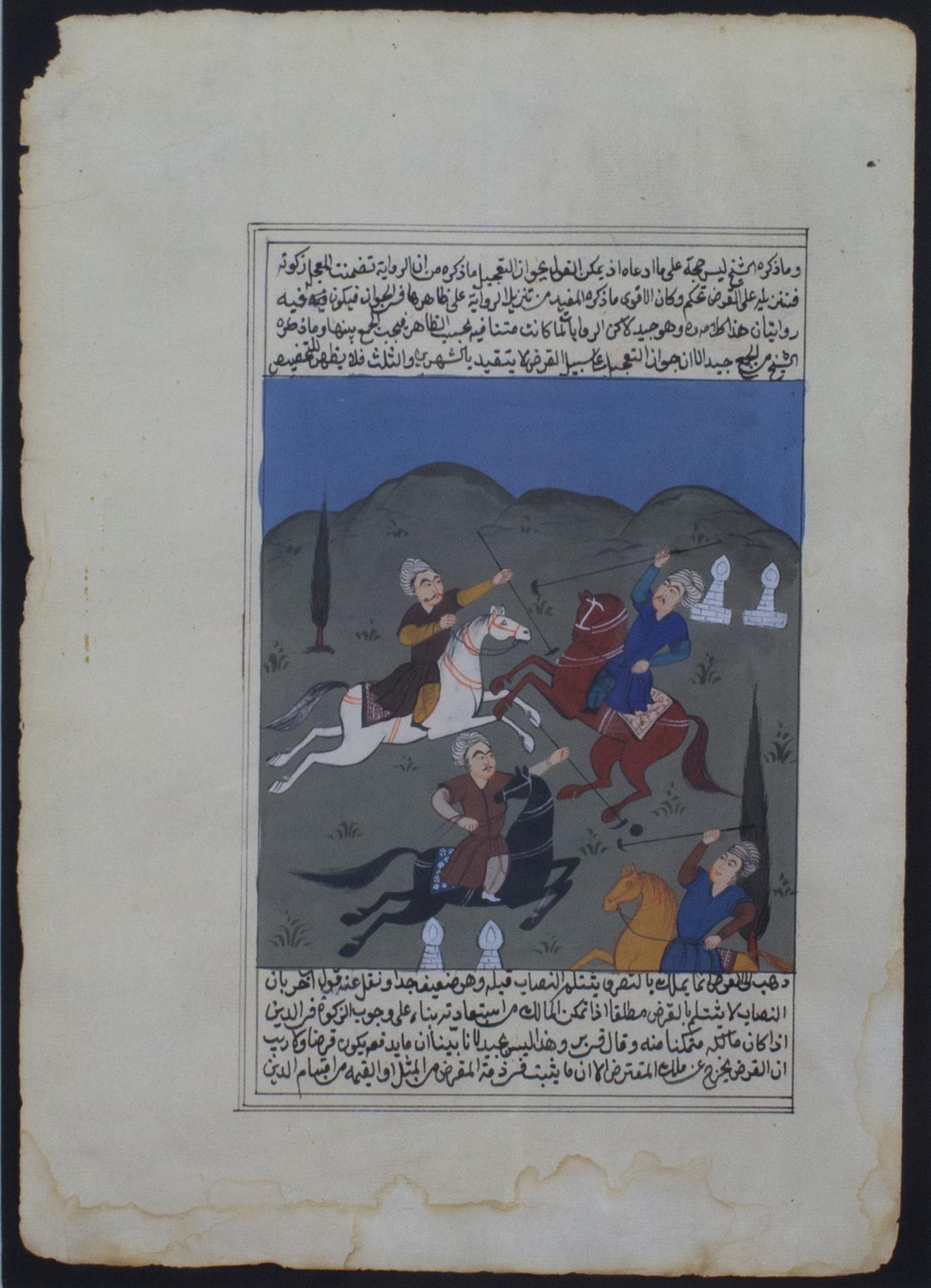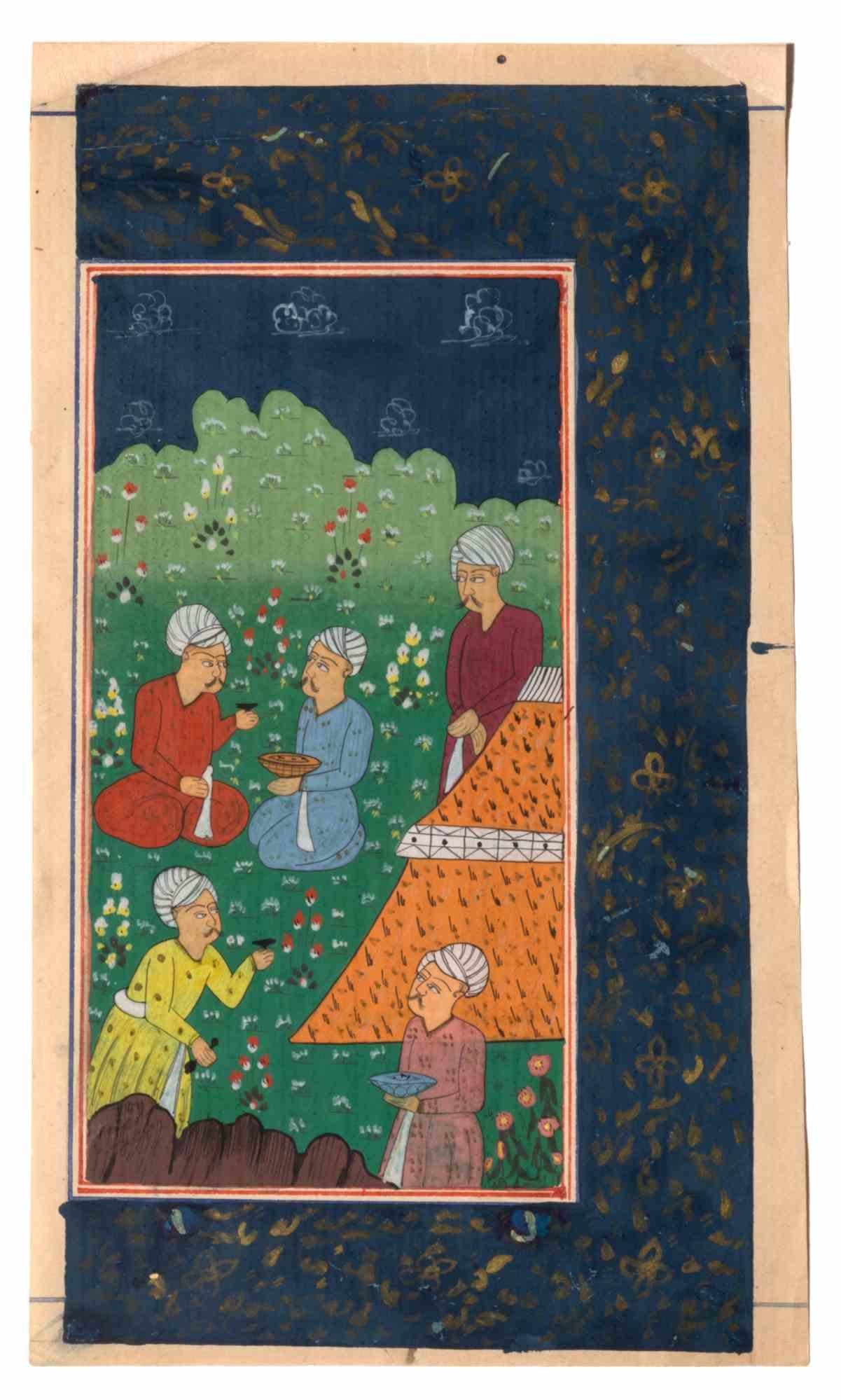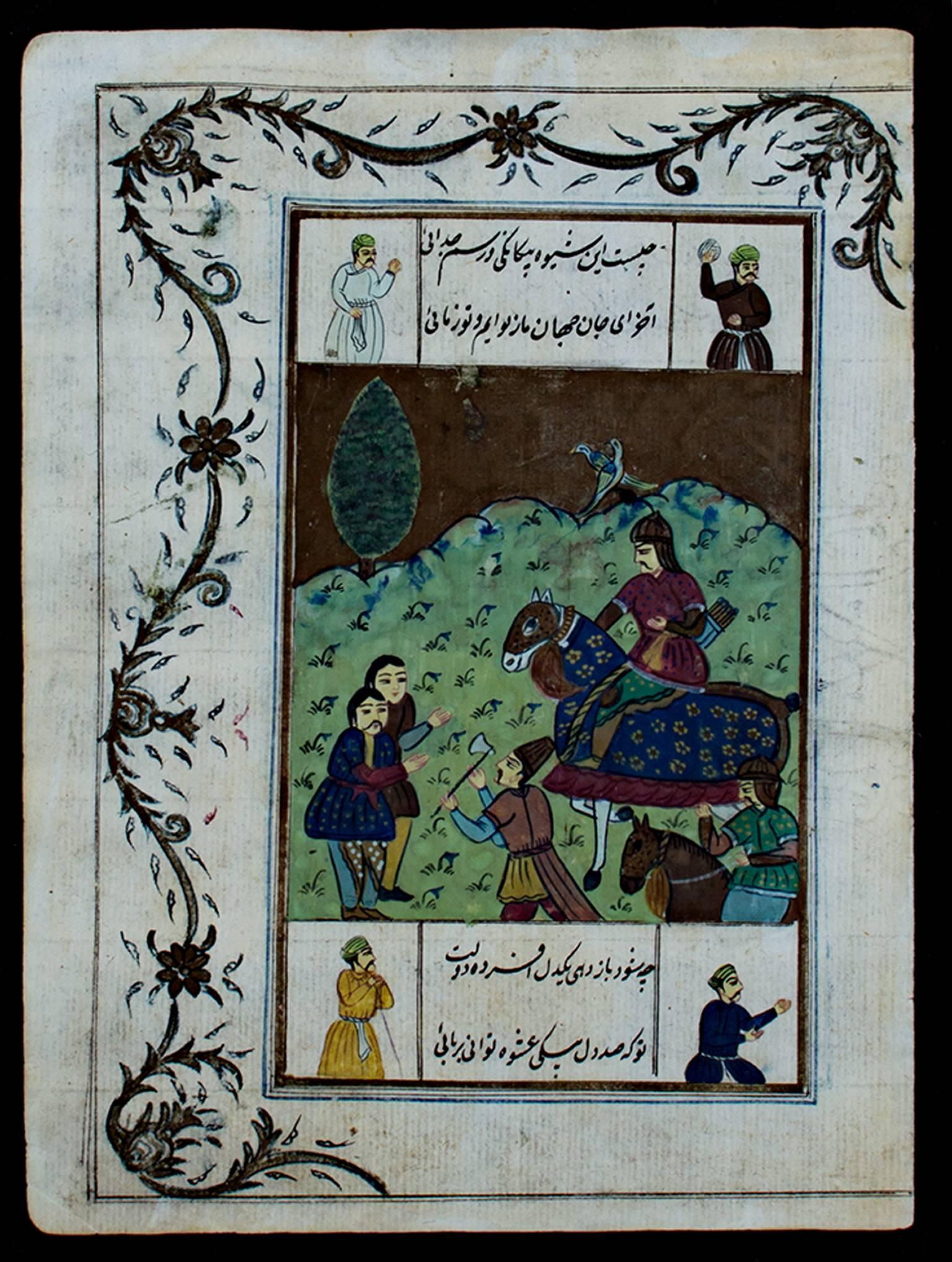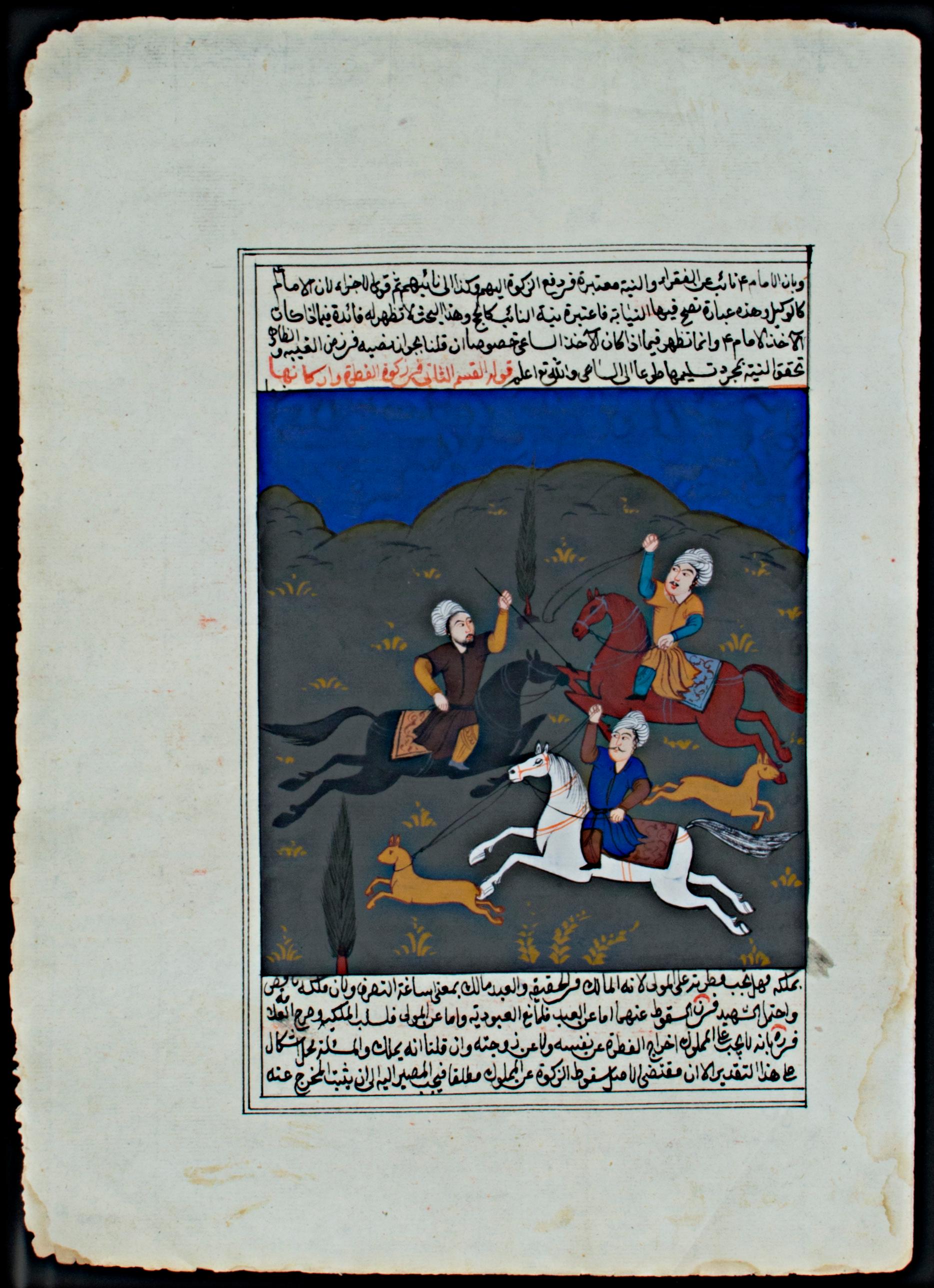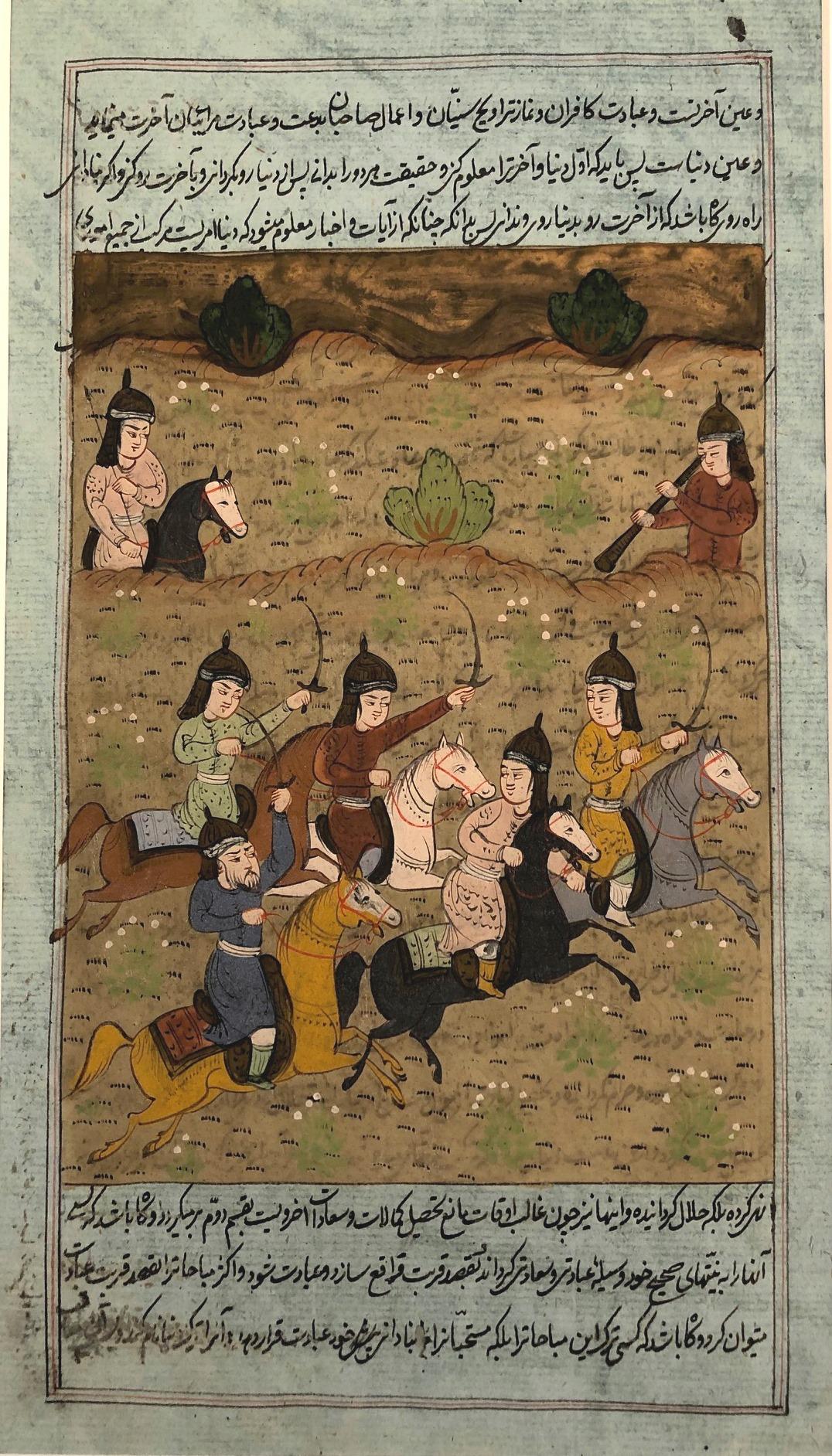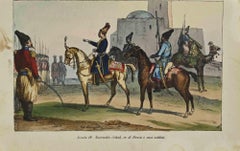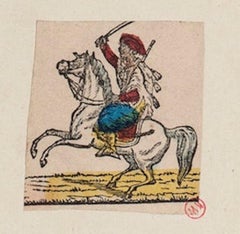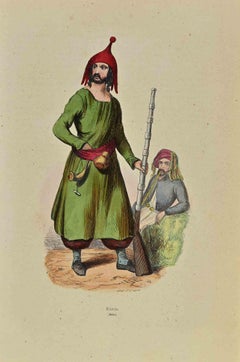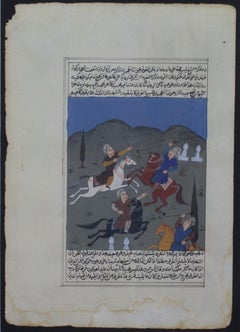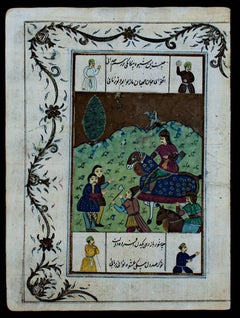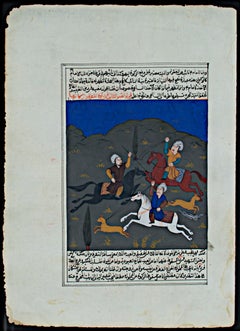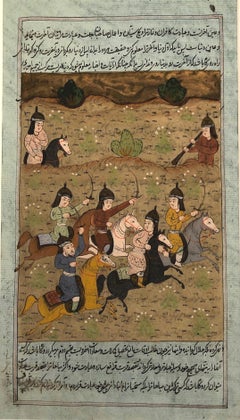Items Similar to Ancient Persian Miniature: Men with Scimitar - Probably 18/19th Century
Want more images or videos?
Request additional images or videos from the seller
1 of 3
UnknownAncient Persian Miniature: Men with Scimitar - Probably 18/19th Century18/19th Century
18/19th Century
$903.14
£668.21
€750
CA$1,248.75
A$1,370.97
CHF 715.24
MX$16,590.69
NOK 8,964.42
SEK 8,446.84
DKK 5,710.52
About the Item
Image dimensions: 15 X 10 cm.
This Persian Miniature scene of men with scimitar is a unique precious original painting on the front with handwriting remedies on the back. A beautiful original tempera painting and China ink on the yellowish parchment in excellent condition. Up and down of miniature there are phrases of remedies. The Persian hand-writing in calligraphy style is in the blue and red frame. There are orders of natural remedies in black ink and some words in red ink. Front and back of the sheet. In between there is original Persian miniature, the scene of fighting is happening in a green field, there are five men in the colorful folk dress of war with the iron hood in head and the scimitar in their hand. While the painting is illustrating the scene of fight is combined by beauty and delicacy of nature and its flower in the green field as in the Persian miniature the Nature is never separable from the human world. The handwriting of the manuscript in the back of the sheet is full of the detailed name of herbs and seeds for the cure of diseases and pains. The scene of the fight is related to the script by how to cure the wounded body. The trace of historical middle east remedies manuscripts is all provided in this unique folio. It is an admirable piece of artwork and traditional medicine document for those who are interested in a rare folio of ancient times and different cultures. The middle east Islamic culture has impressive experimental medicine knowledge which all world is known and has a great and famous face in medicine and alchemy as Ibn Sina (980/1037) and Zakariyya al-Razi (854/930).
- Creation Year:18/19th Century
- Dimensions:Height: 11.23 in (28.5 cm)Width: 6.3 in (16 cm)Depth: 0.08 in (2 mm)
- Medium:
- Period:
- Condition:Insurance may be requested by customers as additional service, contact us for more information.
- Gallery Location:Roma, IT
- Reference Number:Seller: M-1048271stDibs: LU65035597092
About the Seller
4.9
Platinum Seller
Premium sellers with a 4.7+ rating and 24-hour response times
1stDibs seller since 2017
7,709 sales on 1stDibs
Typical response time: 2 hours
- ShippingRetrieving quote...Shipping from: Roma, Italy
- Return Policy
Authenticity Guarantee
In the unlikely event there’s an issue with an item’s authenticity, contact us within 1 year for a full refund. DetailsMoney-Back Guarantee
If your item is not as described, is damaged in transit, or does not arrive, contact us within 7 days for a full refund. Details24-Hour Cancellation
You have a 24-hour grace period in which to reconsider your purchase, with no questions asked.Vetted Professional Sellers
Our world-class sellers must adhere to strict standards for service and quality, maintaining the integrity of our listings.Price-Match Guarantee
If you find that a seller listed the same item for a lower price elsewhere, we’ll match it.Trusted Global Delivery
Our best-in-class carrier network provides specialized shipping options worldwide, including custom delivery.More From This Seller
View AllAncient Persian Miniature - Original China Ink and Watercolour - 19th Century
Located in Roma, IT
Ancient Persian Miniature is an original China Ink and Watercolour realized by an artist of 19th Century.
Good condition for a little brown ...
Category
19th Century Old Masters Figurative Drawings and Watercolors
Materials
Ink, Watercolor
Nasereddin Shah, King of Persia and his Soldiers- Lithograph - 1862
Located in Roma, IT
Persian Cloth in 19th Century is a Hand-colored lithograph on paper realized in 1862.
The artwork belongs to the Suite Uses and customs of all the peoples of the universe: " History...
Category
1860s Modern Figurative Prints
Materials
Lithograph
Arab Knight - Original Hand-color Etching on Paper - 18th Century
Located in Roma, IT
Arab Knight is an original hand-colored etching, realized by a French master craftsman of the 18th century.
With stamp of collection of the lower right. With description in pencil o...
Category
18th Century Figurative Prints
Materials
Etching
Kurdish - Lithograph by Auguste Wahlen - 1844
Located in Roma, IT
Kurdish is a lithograph made by Auguste Wahlen in 1844.
Hand colored.
Good condition.
At the center of the artwork is the original title "Kurde".
The work is part of Suite Moeurs...
Category
1840s Modern Figurative Prints
Materials
Lithograph
Customs - Persian Kings - Lithograph - 1862
Located in Roma, IT
Customs - Persian Kings is a lithograph on paper realized in 1862.
Titled on the lower.
The artwork belongs to the Suite Uses and customs of all the peoples of the universe: " Hist...
Category
1860s Modern Figurative Prints
Materials
Lithograph
Persian Cloth in 19th Century- Lithograph - 1862
Located in Roma, IT
Persian Cloth in 19th Century is a Hand-colored lithograph on paper realized in 1862.
The artwork belongs to the Suite Uses and customs of all the peoples of the universe: " History...
Category
1860s Modern Figurative Prints
Materials
Lithograph
You May Also Like
Persian Illuminated Miniature with Four Figures Playing Polo in a Landscape
Located in Milwaukee, WI
The present illuminated folio page contains a fine miniature depicting four figures playing polo. Polo, also called 'chagun,' was the sport of kings and princes of central Asia and Iran, and the sport probably originated there in the 6th century BCE. Polo matches appear in a large number of early Persian texts, including in the writings of the 10th century epic writer Abu l-Qasim al-Firdawsi: He describes numerous polo matches in his famous 'Shahnameh' (The Persian Book of Kings). This particular illumination also is closely related to an example held at the Smithsonian Museum of Asian Art: a folio from 'Guy u Chawgan' (The ball and the polo-mallet) which shows a polo game with the dervish and the shah.
12 x 8.25 inches, artwork
19.75 x 15.88 inches, frame
accompanied on the back with an image of the verso
framed to conservation standards with a 100% rag silk-lined mat in a gold gilded frame
A Persian miniature is a small Persian painting on paper, whether a book illustration or a separate work of art intended to be kept in an album of such works called a muraqqa. The techniques are broadly comparable to the Western and Byzantine traditions of miniatures in illuminated manuscripts. Although there is an equally well-established Persian tradition of wall-painting, the survival rate and state of preservation of miniatures is better, and miniatures are much the best-known form of Persian painting in the West, and many of the most important examples are in Western, or Turkish, museums. Miniature painting became a significant genre in Persian art in the 13th century, receiving Chinese influence after the Mongol conquests, and the highest point in the tradition was reached in the 15th and 16th centuries. The tradition continued, under some Western influence, after this, and has many modern exponents. The Persian miniature was the dominant influence on other Islamic miniature traditions, principally the Ottoman miniature...
Category
19th Century Other Art Style Figurative Paintings
Materials
Ink, Tempera, Laid Paper
"Two Warriors on Horseback, Foot Soldier, and Civilians, " Persian Book Page
Located in Milwaukee, WI
"Two Warriors on Horseback, Foot Soldier, and Civilians" is an original gold and tempera painting by an unknown Persian artist from the late 19th ...
Category
Late 19th Century Rajput Figurative Drawings and Watercolors
Materials
Gold Leaf
Persian Illuminated Miniature with Three Hunters on Horseback in a Landscape
Located in Milwaukee, WI
The present illuminated folio page contains a fine miniature depicting three figures hunting while on horseback, an image meant to accompany a historic epic. During the medieval period, hunting was an important pastime of male nobility throughout the Islamic world. The Quran itself explicitly endorses hunting and the use of animals to aid in capturing prey: "Lawful to you are foodstuffs that are good to eat and any game that, at your wish, is captured by beasts of prey which train as you do dogs, according to the method that Allah has taught you, after you have spoken the name of Allah over it." (Q 6:4) Muslim princes and nobles enjoyed the chase of the prey via horseback, using bow and arrow, crossbows, and blowpipes to capture their prey Horseback riding itself trained young men in the necessary skills for armed combat and warfare, developing their speed and strength.
12 x 8.25 inches, artwork
19.75 x 15.88 inches, frame
accompanied on the back with an image of the verso
framed to conservation standards with a 100% rag silk-lined mat in a gold gilded frame
A Persian miniature is a small Persian painting on paper, whether a book illustration or a separate work of art intended to be kept in an album of such works called a muraqqa. The techniques are broadly comparable to the Western and Byzantine traditions of miniatures in illuminated manuscripts. Although there is an equally well-established Persian tradition of wall-painting, the survival rate and state of preservation of miniatures is better, and miniatures are much the best-known form of Persian painting in the West, and many of the most important examples are in Western, or Turkish, museums. Miniature painting became a significant genre in Persian art in the 13th century, receiving Chinese influence after the Mongol conquests, and the highest point in the tradition was reached in the 15th and 16th centuries. The tradition continued, under some Western influence, after this, and has many modern exponents. The Persian miniature was the dominant influence on other Islamic miniature traditions, principally the Ottoman miniature...
Category
19th Century Other Art Style Figurative Paintings
Materials
Ink, Tempera, Laid Paper
19th Century Mughal Painting of Battle scene
Located in Greenwich, CT
An illuminated page from a book likely in reference to Emperor Jahangir's reign over the Mughal Empire.
Gouache and ink on light weight cream laid paper circa 1800 or earlier,
Exte...
Category
Late 19th Century Other Art Style Paintings
Materials
Gouache
Vivid Safavid: Enchanted Tales of Persia - Gold Highlighted Miniature Manuscript
Located in Langweer, NL
A manuscript page containing Persian miniature painting, surrounded by script. This artwork is characteristic of Islamic manuscript illumination, pa...
Category
Antique Early 18th Century Persian Decorative Art
Materials
Paper
$497 Sale Price
30% Off
Mughal School, 17th century Tiger Hunt near the Jahangir Maha, Agra
Located in Middletown, NY
An illuminated page from a book likely in reference to palace life during Emperor Jahangir's reign over the Mughal Empire.
c 1690. Gouache and ink with heightening in gold on light ...
Category
17th Century Rajput Figurative Drawings and Watercolors
Materials
Gold
More Ways To Browse
Miniature Paintings From 19th Century
Antique Tempera Painting
Persian Miniature
Miniature Scene
Antique Handwriting
Antique Persian Painting
Antique Persian Miniatures
Persian Miniature Painting
Antique Scimitar
Conrad Divine
Craig Rubadoux
Dali Pencil Drawing
Dalva Duarte
Elizabeth Mary Watt
Elizabeth Wilcox
Favretto Painting
Frank M Hamilton
G Town Jewelers New York
